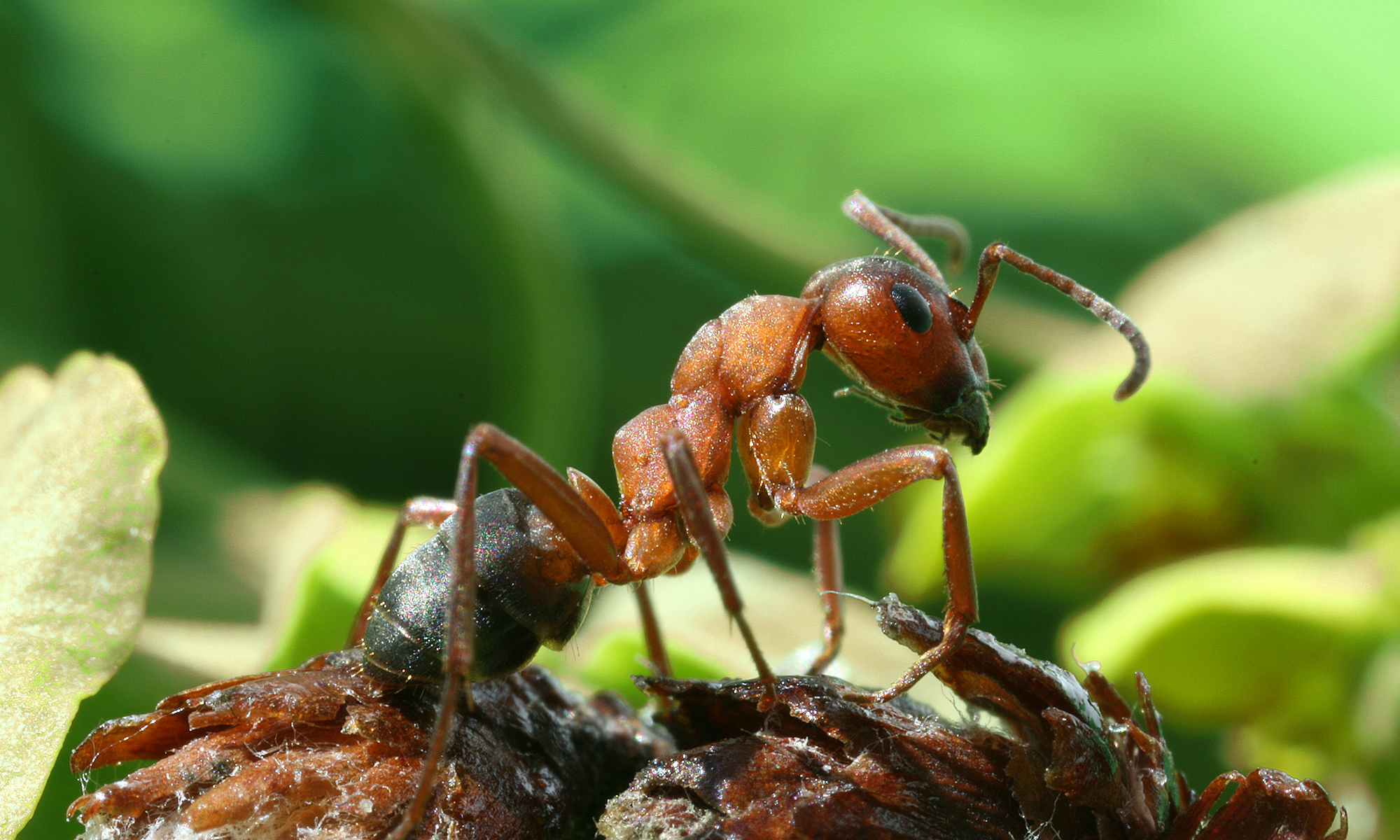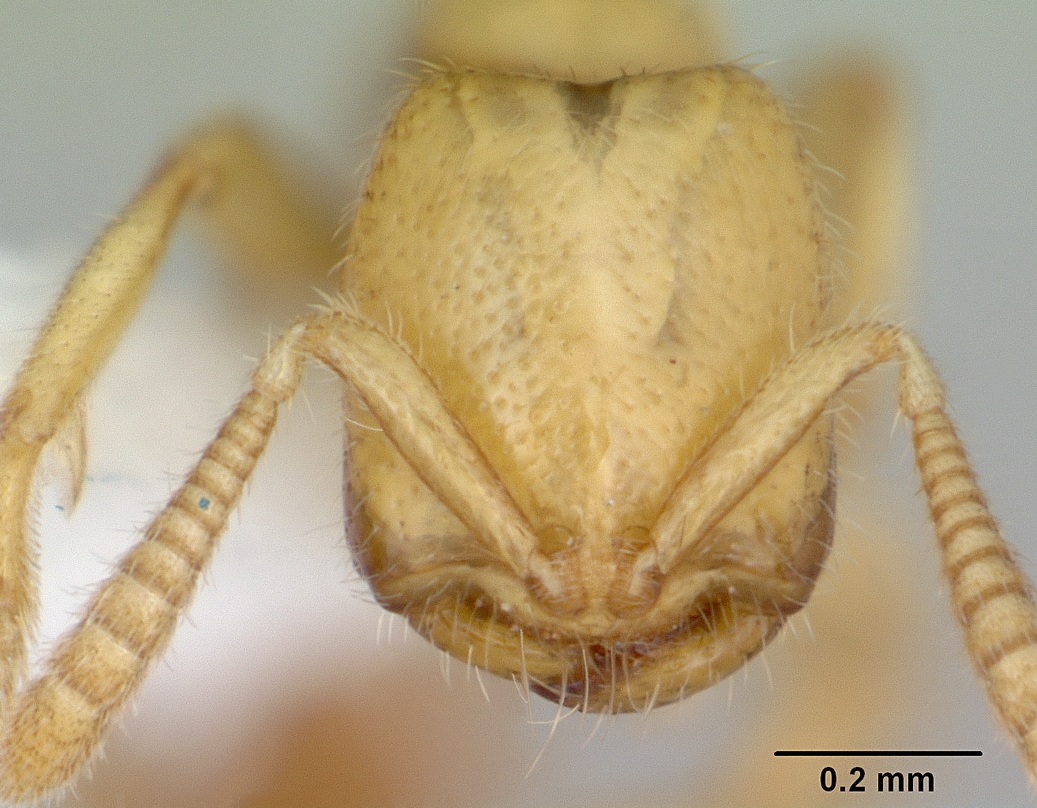|
Amblyoponinae
Amblyoponinae is a subfamily of ants in the poneromorph subfamilies group containing 13 extant genera and one extinct genus. The ants in this subfamily are mostly specialized subterranean predators. Adult workers pierce the integument (non lethally) of their larvae and pupa to imbibe haemolymph, earning them the common name Dracula ant. Identification Amblyoponinae is characterized by these worker characters: eyes small or absent, situated behind midlength of side of head; anterior margin of clypeus with specialized dentiform setae; promesonotal suture flexible; petiole very broadly attached to abdominal segment 3 and without a distinct posterior face; postpetiole absent; sting present and well developed. Systematics The subfamily was formerly considered a tribe within Ponerinae, but was elevated to its own subfamily in 2003 when Barry Bolton divided Ponerinae into six subfamilies. *Amblyoponinae Forel, 1893 ** Amblyoponini Forel, 1893 *** ''Adetomyrma ''Adetomyrma'' is a ... [...More Info...] [...Related Items...] OR: [Wikipedia] [Google] [Baidu] |
Ant Subfamilies
Ants (family (biology), family Formicidae in the Order (biology), order Hymenoptera) are the most species-rich of all social insects, with more than 12,000 described species and many others awaiting description. Formicidae is divided into 21 subfamily, subfamilies, of which 17 contain Extant taxon, extant Taxon, taxa, while four are exclusively fossil. Ants have come to occupy virtually all major terrestrial habitats, with the exception of tundra and cold ever-wet forests. They display a wide range of social behaviors, foraging habits and associations with other organisms, which has generated scientific and public interest. Clades Beginning in the 1990s, molecular (DNA sequence) data have come to play a central role in attempts to reconstruct the ant "Tree of life (biology), tree of life". Molecular phylogenetics, Molecular phylogenetic analyses based on multiple nuclear genes have yielded robust results that reinforce some preexisting views but overturn others – and sugges ... [...More Info...] [...Related Items...] OR: [Wikipedia] [Google] [Baidu] |
Mystrium
''Mystrium'' is a rare genus of ants in the subfamily Amblyoponinae. First described by Roger (1862) with the description of the queen of '' M. mysticum'', the genus contains 14 species, all of which occur in the rainforests of the Old World with over half of the species endemic to the Malagasy region. Distribution All species occur in the rainforests of the Old World, with most found in tropical Africa: ten of them are restricted to Madagascar (and its adjacent islands) and one is recorded from continental Africa (''M. silvestrii''). ''M. camillae'' is widespread in the Indo-Australian region, and ''M. leonie'' and ''M. maren'' are known from Indonesia. Taxonomic history After Roger (1862) established ''Mystrium'' with a single species from Madagascar, ''Mystrium mysticum'', Forel described five additional species in the Malagasy region between 1895 and 1899. The first record of ''Mystrium'' outside the Malagasy region was ''Mystrium camillae'' from Myanmar, and the second wa ... [...More Info...] [...Related Items...] OR: [Wikipedia] [Google] [Baidu] |
Xymmer
''Xymmer'' is a genus of ant in the subfamily Amblyoponinae containing the single species ''Xymmer muticus''. Taxonomy ''Xymmer'' was first described by Santschi (1914) as a monotypic subgeneric taxon under '' Stigmatomma''. Since Santschi's original description, ''Xymmer'' was raised to genus by Wheeler (1922) in his identification key for African Amblyoponini. Clark (1934) regarded ''Xymmer'' as a subgenus in '' Amblyopone'' following Wheeler's suggestion; however, distinguishing characters were not discussed in their treatments. Brown (1949, 1960) discussed separable characters for ''Xymmer'' (as a junior synonym under the subgenus ''Stigmatomma'') for the first time since Santschi's original description. Brown regarded ''Stigmatomma'' and its related names as junior synonyms of ''Amblyopone'' at that time. ''Xymmer'' was resurrected to its current placement as an independent genus from synonymy A synonym is a word, morpheme, or phrase that means precisely or nearly the sa ... [...More Info...] [...Related Items...] OR: [Wikipedia] [Google] [Baidu] |
Adetomyrma
''Adetomyrma'' is a genus of ants endemic to Madagascar. Workers of this genus are blind. The type species '' Adetomyrma venatrix'' was described in 1994, with the genus being an atypical member of its tribe, the Amblyoponini. This tribe includes the Dracula ants, members of which can feed on the hemolymph of larvae and pupae. Taxonomy ''Adetomyrma'' was first described as a Malagasy endemic monotypic genus by Ward in 1994. Ward (1994) assigned this genus to Amblyoponini within the subfamily Ponerinae on the basis of the worker morphology Morphology, from the Greek and meaning "study of shape", may refer to: Disciplines *Morphology (archaeology), study of the shapes or forms of artifacts *Morphology (astronomy), study of the shape of astronomical objects such as nebulae, galaxies, ... of the type species ''Adetomyrma venatrix''. Later, Bolton (2003) raised this tribe to subfamily status as Amblyoponinae. Biology The colonies, the first of which was found in a rotting log, m ... [...More Info...] [...Related Items...] OR: [Wikipedia] [Google] [Baidu] |
Casaleia
''Casaleia'' is an extinct genus of ants in the formicid subfamily Amblyoponinae described by Pagliano & Scaramozzino in 1990 from fossils found in Europe. The genus contains four species dating from the Eocene to Miocene, ''Casaleia eocenica'', ''Casaleia inversa'', ''Casaleia longiventris'', ''Casaleia orientalis''. History and classification The species placed in ''Casaleia'' have a varied history, with the type species ''Casaleia inversa'' originally described by Gennady Dlussky in 1981 as ''"Protamblyopone" inversa''. The fossil was recovered from Middle Miocene age sediments exposed in the Chon-Tyz mine, Naryn Region, Kyrgyzstan. However "Protamblyopone" was already used by William Morton Wheeler as a subgenus of '' Amblyopone''. To correct the homonym status, the species was moved to the new genus ''Casaleia'' by Pagliano and Scaramozzino in a 1990 paper. The second species in the genus, ''C. eocenica'', is of Lutetian age, and was recovered as a solitary compres ... [...More Info...] [...Related Items...] OR: [Wikipedia] [Google] [Baidu] |
Stigmatomma
''Stigmatomma'' is a genus of ants in the subfamily Amblyoponinae. The genus has a worldwide distribution, and like most other amblyoponines, ''Stigmatomma'' species are specialized predators. First described by Roger (1859), it was for a long time considered to be a synonym of '' Amblyopone'' until it was revived as an independent genus by Yoshimura & Fisher (2012) based on worker mandible morphology. Species *''Stigmatomma amblyops'' Karavaiev, 1935 *'' Stigmatomma annae'' (Arnol'di, 1968) *'' Stigmatomma awa'' (Xu & Chu, 2012) *''Stigmatomma bellii'' (Forel, 1900) *''Stigmatomma besucheti'' (Baroni Urbani, 1978) *''Stigmatomma bolabola'' Esteves & Fisher, 2016 *'' Stigmatomma boltoni'' (Bharti & Wachkoo, 2011) *'' Stigmatomma bruni'' Forel, 1912 *'' Stigmatomma caliginosum'' (Onoyama, 1999) *'' Stigmatomma crenatum'' (Xu, 2001) *''Stigmatomma crypticum'' (Eguchi et al., 2015) *'' Stigmatomma denticulatum'' Roger, 1859 *†'' Stigmatomma electrinum'' (Dlussky, 2009) *'' Stigm ... [...More Info...] [...Related Items...] OR: [Wikipedia] [Google] [Baidu] |
Onychomyrmex
''Onychomyrmex'' is an Australian genus of ants in the subfamily Amblyoponinae. Its three species are known from eastern Queensland, Australia. Although not true army ants, ''Onychomyrmex'' species display an army-ant life style, including group predation and nomadism. Distribution The genus is known from Queensland, Australia, where it is found living mainly in rotten logs in the rainforests along the eastern coast. Their distribution may range into the northeastern New South Wales. The type localities of the three species are: Kuranda (''O. doddi''), Mount Bellenden Ker (''O. hedleyi'') and Herberton (''O. mjobergi''). Description Species have an army-ant life style, including group predation and nomadism. Queens are similar to the true army ants (subfamily Dorylinae). That is, ''Onychomyrmex'' queens are dichthadiiform, having a broadened head, very small eyes, worker-like alitrunk without wings or sclerites, and an elongated bulky gaster. However, belonging to the tribe ... [...More Info...] [...Related Items...] OR: [Wikipedia] [Google] [Baidu] |
Prionopelta
''Prionopelta'' is a genus of ants in the subfamily Amblyoponinae. Of its 15 species, four are known from Africa, five from the Americas and six from the Indo-Pacific The Indo-Pacific is a vast biogeographic region of Earth. In a narrow sense, sometimes known as the Indo-West Pacific or Indo-Pacific Asia, it comprises the tropical waters of the Indian Ocean, the western and central Pacific Ocean, and the ... region. Species *'' Prionopelta aethiopica'' Arnold, 1949 *'' Prionopelta amabilis'' Borgmeier, 1949 *'' Prionopelta amieti'' Terron, 1974 *'' Prionopelta antillana'' Forel, 1909 *'' Prionopelta brocha'' Wilson, 1958 *'' Prionopelta descarpentriesi'' Santschi, 1924 *'' Prionopelta humicola'' Terron, 1974 *'' Prionopelta kraepelini'' Forel, 1905 *'' Prionopelta majuscula'' Emery, 1897 *'' Prionopelta marthae'' Forel, 1909 *'' Prionopelta media'' Shattuck, 2008 *'' Prionopelta modesta'' Forel, 1909 *'' Prionopelta opaca'' Emery, 1897 *'' Prionopelta punctulata'' Mayr, ... [...More Info...] [...Related Items...] OR: [Wikipedia] [Google] [Baidu] |
Adetomyrma Venatrix
''Adetomyrma venatrix'', more commonly known as the "Dracula ant" due to its habit of drinking the blood of its young, is an endangered species of ants endemic to Madagascar. Workers of this species are blind. The species was described as the type species of '' Adetomyrma'' in 1994, with the genus being an atypical member of its tribe. Description ''Adetomyrma venatrix'' was described on the basis of specimens belonging to the worker caste collected from Zombitse Forest, in western Madagascar. The key characteristics of the species was the absence of a clear petiole when viewed from above due to the third abdominal tergite (the sclerite on the dorsal side) lacking a differentiated pretergite. The gaster is large and without constrictions. The ant is blind and has a long sting. It was placed with reservations in the tribe Amblyoponini as it lacks the typical characters of the group. Later studies considered them as being close to the ancestral An ancestor, also known as ... [...More Info...] [...Related Items...] OR: [Wikipedia] [Google] [Baidu] |
Amblyopone
''Amblyopone'' is a genus of 10 species of ants, found in Australia, New Caledonia, New Guinea and New Zealand New Zealand () is an island country in the southwestern Pacific Ocean. It consists of two main landmasses—the North Island () and the South Island ()—and List of islands of New Zealand, over 600 smaller islands. It is the List of isla ....Yoshimura, M.; Fisher, B.L. 2012: A revision of male ants of the Malagasy Amblyoponinae (Hymenoptera: Formicidae) with resurrections of the genera ''Stigmatomma'' and ''Xymmer''. ''PLoS One'', 7(3): e33325. reference page Ants of this genus possess gamergates, meaning workers are able to reproduce within a colony lacking a queen. Species *'' Amblyopone aberrans'' Wheeler, 1927 *'' Amblyopone australis'' Erichson, 1842 *'' Amblyopone clarki'' Wheeler, 1927 *'' Amblyopone ferruginea'' Smith, 1858 *'' Amblyopone gingivalis'' Brown, 1960 *'' Amblyopone hackeri'' Wheeler, 1927 *'' Amblyopone leae'' Wheeler, 1927 *'' Amblyopo ... [...More Info...] [...Related Items...] OR: [Wikipedia] [Google] [Baidu] |
Fulakora
''Fulakora'' is a genus of ants in the subfamily Amblyoponinae. The genus has a worldwide distribution, and like most other amblyoponines, ''Fulakora'' species are specialized predators. It was originally described as, and for a long time considered to be, a subgenus of ''Stigmatomma ''Stigmatomma'' is a genus of ants in the subfamily Amblyoponinae. The genus has a worldwide distribution, and like most other amblyoponines, ''Stigmatomma'' species are specialized predators. First described by Roger (1859), it was for a long ...'' until it was elevated to an independent genus by Ward & Fisher (2016). Species *'' Fulakora agostii'' (Lacau & Delabie, 2002) *'' Fulakora armigera'' (Mayr, 1887) *'' Fulakora bierigi'' (Santschi, 1930) *'' Fulakora celata'' (Mann, 1919) *'' Fulakora chilensis'' (Mayr, 1887) *'' Fulakora cleae'' (Lacau & Delabie, 2002) *'' Fulakora degenerata'' (Borgmeier, 1957) *'' Fulakora egregia'' (Kusnezov, 1955) *'' Fulakora elongata'' (Santschi, 1912) *'' Fula ... [...More Info...] [...Related Items...] OR: [Wikipedia] [Google] [Baidu] |



